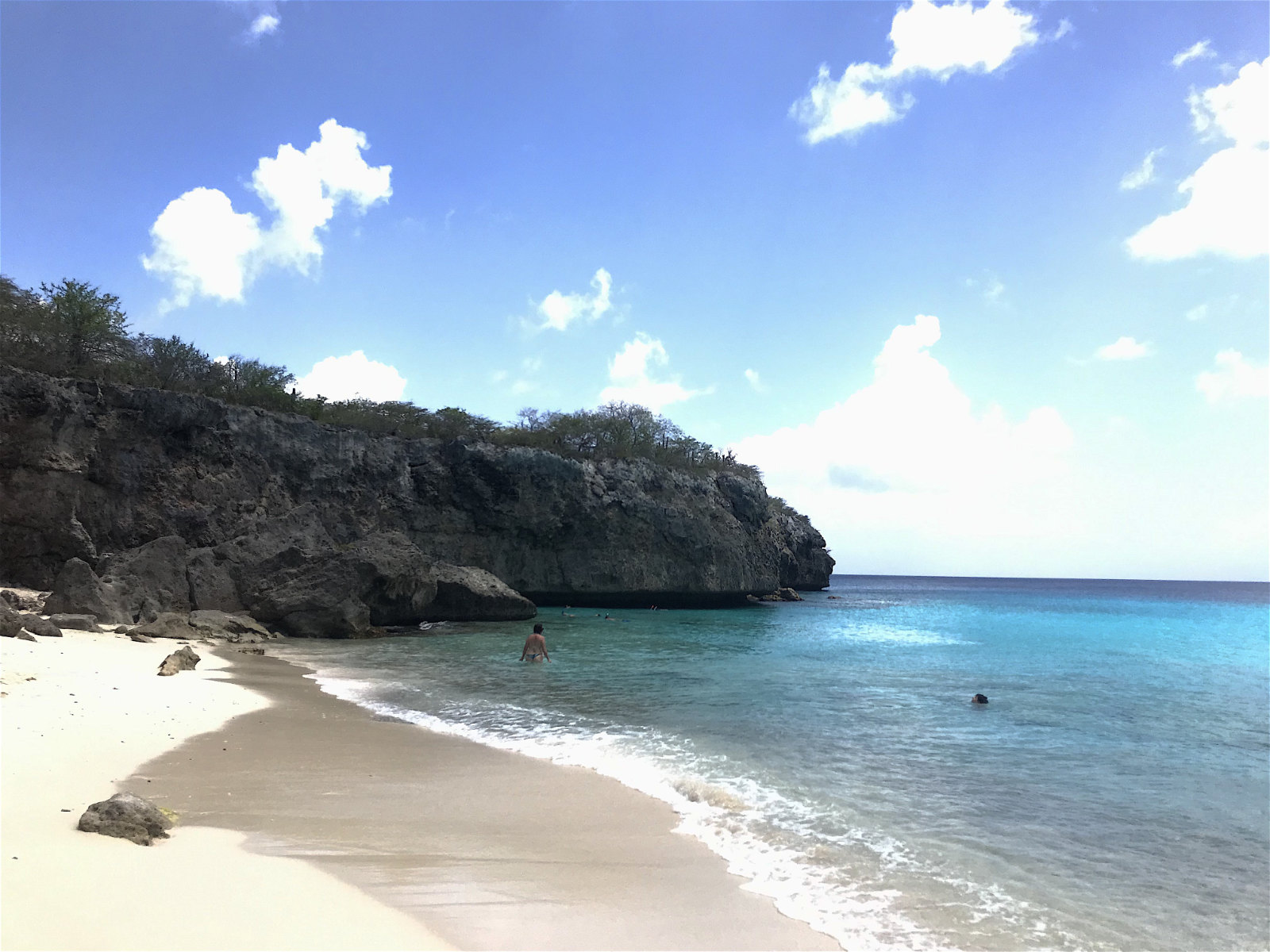
Above: Playa Jeremi.
VOLANTE Leyla Messian explores the rich, multicultural heritage of Curaçao
Photographed by the author and by Elyse Glickman
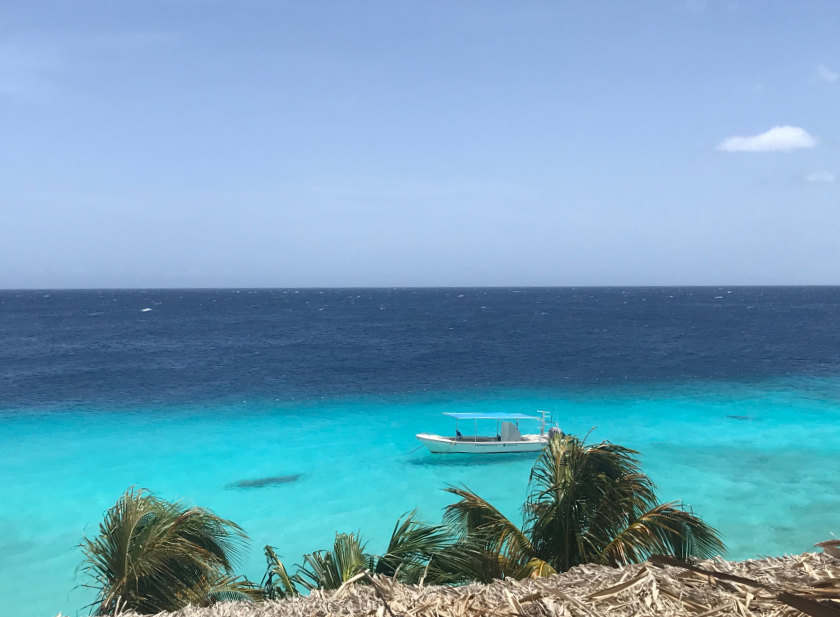
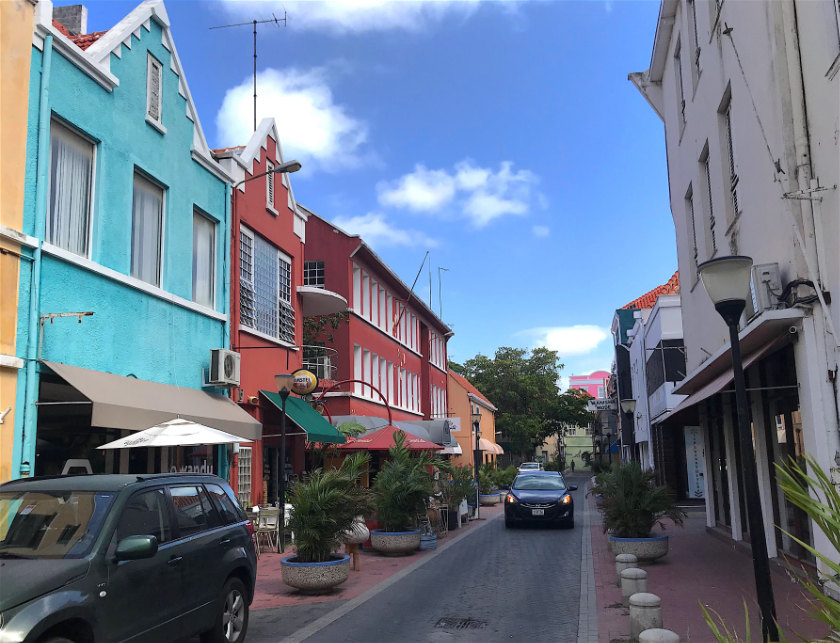
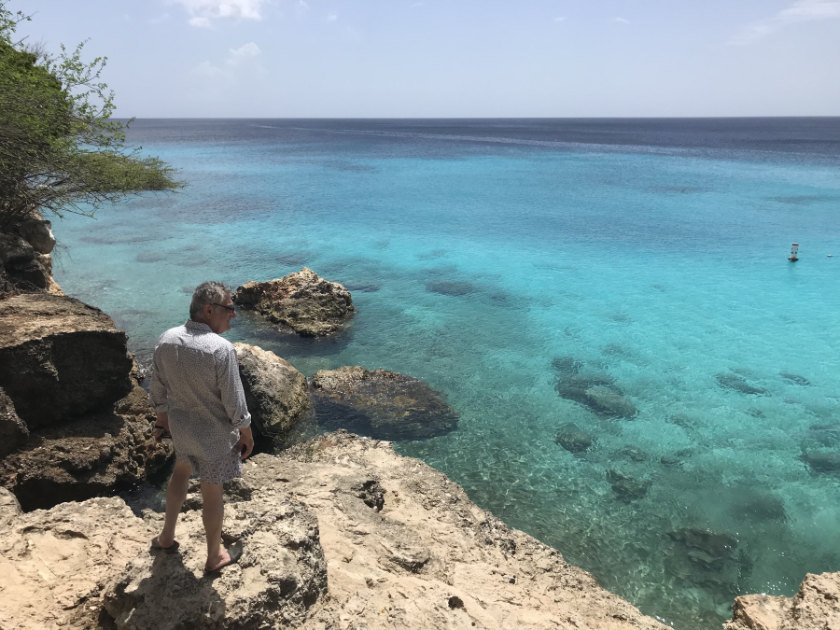

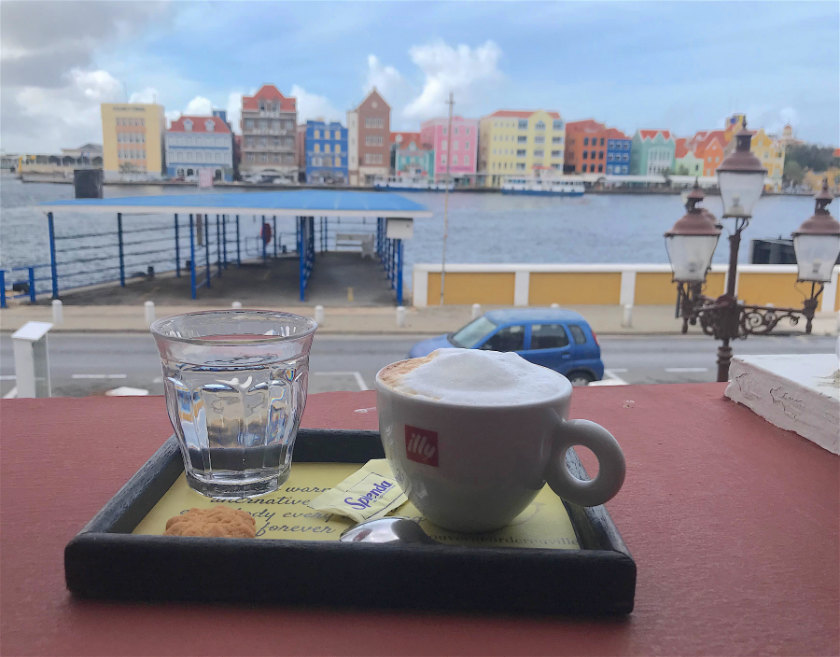 Above, from top: Another pristine beach. Columbusstraat. Playa Kenepa. A hilltop view. Morning view with a coffee.
Above, from top: Another pristine beach. Columbusstraat. Playa Kenepa. A hilltop view. Morning view with a coffee.
Leyla Messian is a senior writer for Lucire.
Lots of Caribbean islands promise sun, fun, and beachfront properties. Curaçao, on the other hand, delivers something far more substantial even with its size being close to that of Rhode Island. It’s a fully formed country with a distinctive and rich cultural history, a multi-dimensional culinary destination, and an arts’ scene defined by the people of different cultures who brought their influence to the fore when they set down roots.
Before heading off on your adventure, it’s a good idea to relax for a day or two at Acoya, an inviting resort a short drive from the city centre. You may spend an afternoon lounging in the lakeside infinity pool, or enjoy a full island barbecue buffet before returning to your comfortable apartment-style room or suite. You can choose an all-inclusive option, but as most rooms come with a kitchen, you can drive into town to pick up produce or takeaway meals. As you leave Acoya, don’t be intimidated by the local biker bar, Hogs’ Nest. Harley aficionados park their “hogs” outside and are happy to show off these mobile works of art to anybody interested in checking them out.
Pietermaai Smal is an area of Willemstad that combines the trendiest entertainment and dining spots with the architecture of Curaçao’s past. Twenty years ago, these oceanfront colonial residences and warehouses were returning to the elements. Dutch expats began to restore these abandoned buildings to their 18th-century splendour. Today, the neighbourhood consists of rainbow-hued rows of blue boutique hotels, pink B&Bs, and yellow private homes interspersed with red and green modern apartments. A visitor would be hard pressed to find two buildings that were the same.
The Pietermaai Boutique Hotel, housed in a Dutch colonial seafoam green-and-white building facing the sea, offers four-star rooms as well as appealing budget accommodations in an adjacent row of storage rooms from centuries past. Where sugar was once stored, today there are modern lofts outfitted with a kitchen, glass shower, and stone sink. Included with a stay is breakfast at Ginger, a Carib-Asian restaurant accessed through a shrub-covered alley. Guests may choose the tasting platter, bite-sized highlights of the menu including curried pumpkin soup, pastechi, Dutch cheese, and pineapple guava juice. Dinner at Ginger is a must for those seeking tandoori specialties, and spicy vegetarian options are available.
For travellers wishing to stay longer, Pietermaai Apartments allows you to live like a local at affordable prices. First, choose your colour: red, blue, or green. Many of these modern-minimalist flats are two-storey lofts with soundproof glass interior walls. Windows face out to an indigo and turquoise ocean, and balconies offer views of pub crawlers strolling beneath the fairy lights adorning Nieuweststrat. Bistro Pietermaai (located behind the hotel), serves a selection of seafood dishes with Dutch flair: the vegetarian pasta consists of broccoli in pesto sauce finished with large slabs of brie melted on top. One begins to wonder if cheese grows on trees in Curaçao. Around the corner, classic rock rules supreme at 27, a shrine to rock stars gone too soon. Six nights a week, local bands play classic and alternative rock to standing-room-only crowds. To those who left us at age 27—to Kurt, Amy, Jimi, and Janis—Curaçao raises a glass of Dutch, Caribbean, or Venezuelan beers.
Rock-and-roll gives away to salsa and merengue every Thursday night during Punda Vibes. When the sun sets, you will walk along the bay to Columbusstraat, and turn in the direction of the music. Punda Vibes is a block party where revellers pay homage to the island’s African heritage. In the street, white-clad dancers keep time with Curaçao’s traditional folk music. If you wait patiently in line and ask, they will teach you their moves. The melodies and dances harken back to Angola, Mozambique and the Congo, the ancestral countries for much of the island’s population. However, this is not a historical relic. African culture informs everything in Curaçao, from the penchant for colour to dishes such as funchi-fries and yiambo (seafood and okra soup).
The bars and restaurants in Punda and Pietermaai are prime spots to meet people and sip strong mojitos. During the all-day happy hour at the World’s Best Mojito Bar (Columbusstraat 6), the signature cocktails are two for one. With drinks this strong, you will need food in your stomach. The staff is fine with your bringing in some barbecue from El Gordo next door. Just fill up a box with chicken, beef or pork, add red beans, rice and plantains, and you are good to go. Those who prefer to eat healthy will enjoy La Bohème located on the other side of the mojito bar. This local hangout whips up a large selection of tropical fruit and green leafy vegetable smoothies, some blended with the island’s prime cash crop—alœ vera. It also serves deep fried corn arepas stuffed with your choice of chicken, vegetables, and, of course, more cheese.
continued below
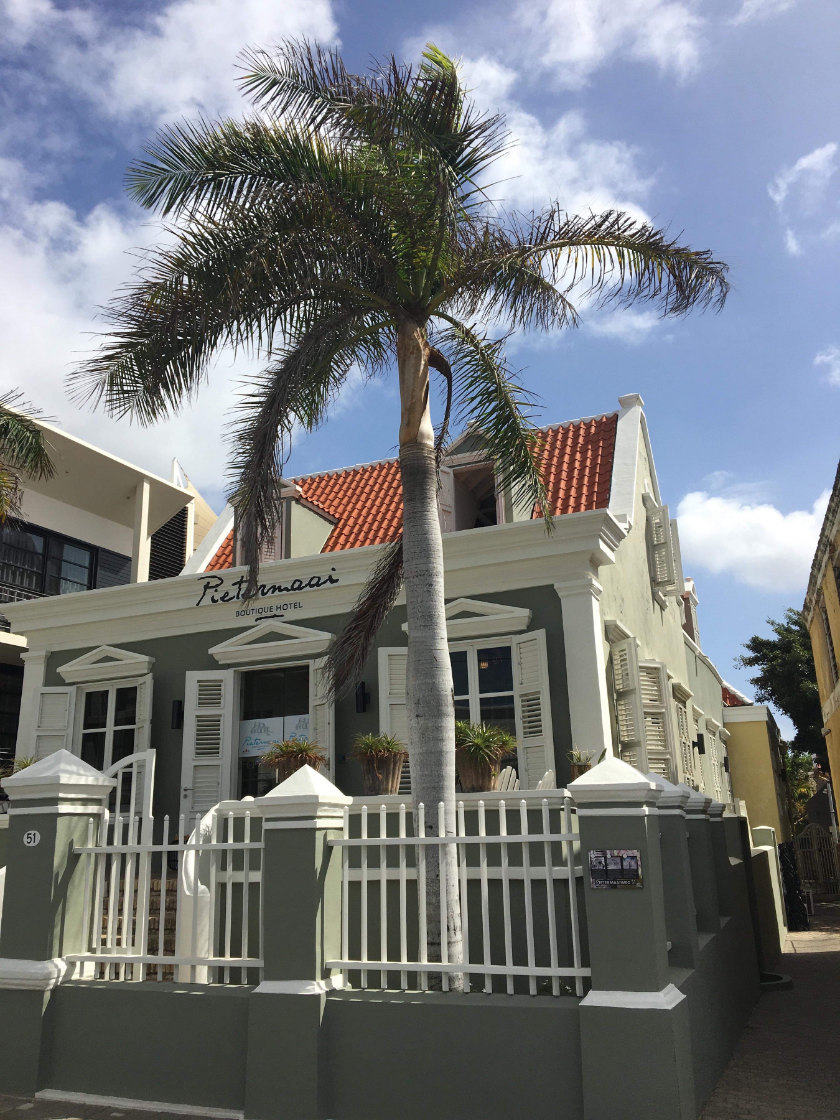

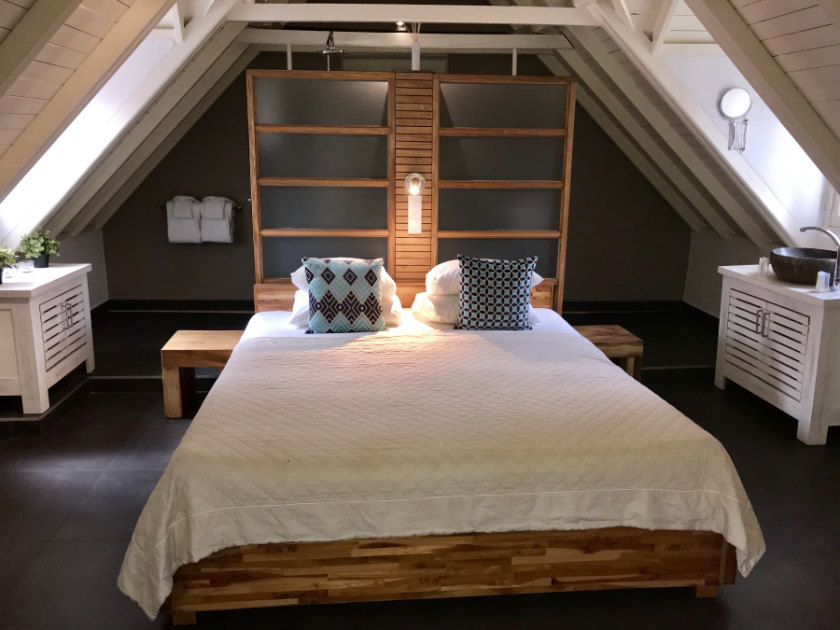
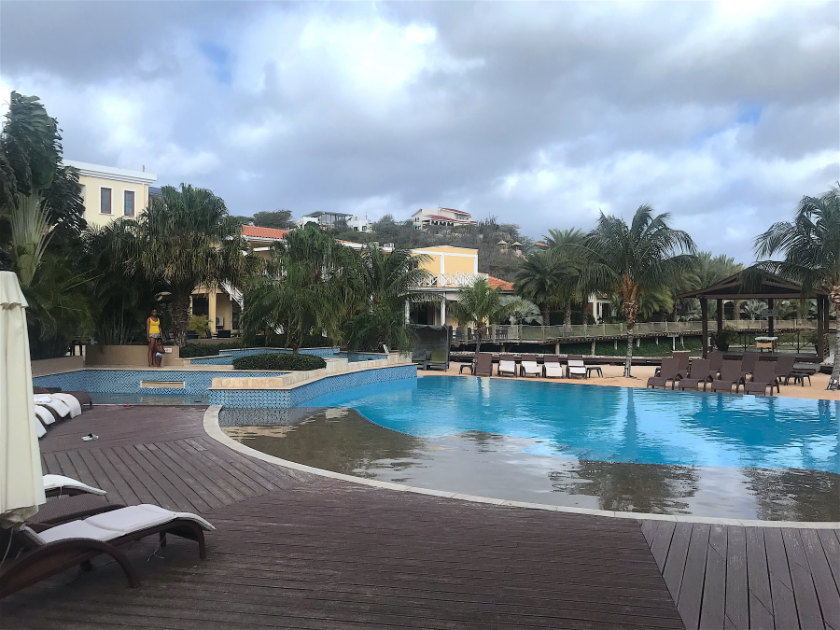
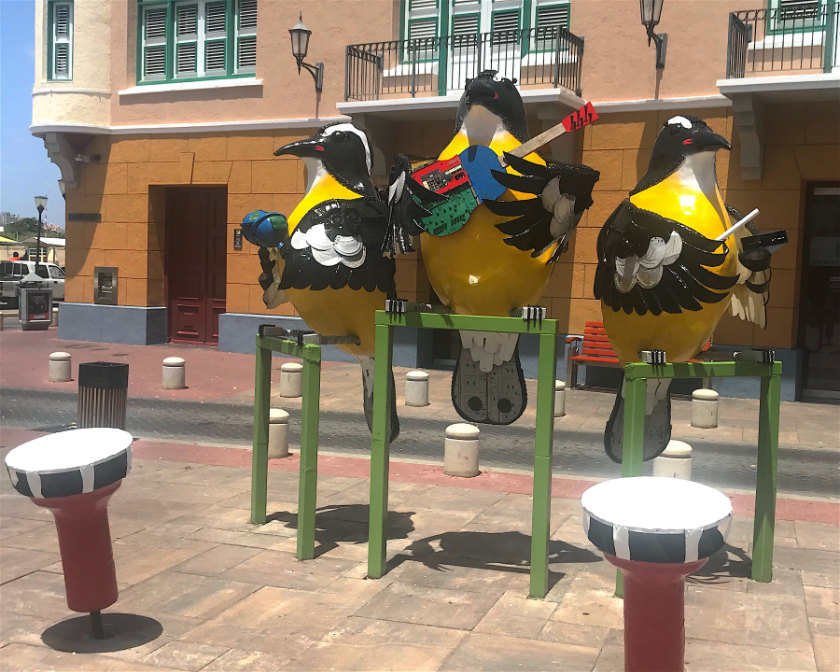
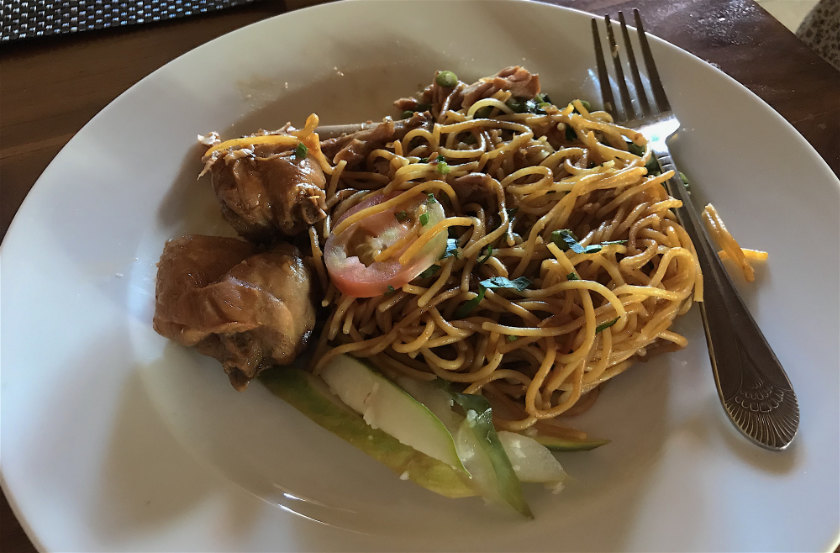 Above, from top: The Pietermaai boutique hotel. A suite at the Pietermaai. View of the pools from the Pietermaai. Acoya pool. Punda Street Art.
Chicken bami at Smulla.
Above, from top: The Pietermaai boutique hotel. A suite at the Pietermaai. View of the pools from the Pietermaai. Acoya pool. Punda Street Art.
Chicken bami at Smulla.
Punda Vibes continues at Mundo Bizarro. Customers sip mojitos and daiquiris while lounging on wrought iron chairs or old sofas placed on the sidewalk. Since its menu includes a large selection of rum, it’s a good place to evoke your inner Ernest Hemingway. An enormous stencil of Che adorns the balcony wall overlooking the entrance to a room decorated in deep reds and burnished gold. It’s 1950s Havana again, on the eve of the revolution as couples dance to live salsa.
Weekends in Pietermaai and Punda end at late-night venues like Blackjack Lounge and Bar, located steps from the beach. This sleek bar specializes in craft cocktails as well as retro tiki creations. The skinny, piquant habanero margarita pairs well with poke bowls and shawarma tacos. It’s a local hangout frequented by young and sophisticated patrons: DJ Dorene Woodz spins the latest Afrobeats, Latin house and remixes every Saturday, and is available for destination weddings and other private events. When you return to your downtown lodgings, you will probably fall asleep to Afro-Cuban drumming coming from Cuba Shango Bar and Lounge located in an alley (Fuikstraat 3), where those who still don’t want to go home congregate for the night’s last call.
When the sun is up, it is time to dig a little deeper into the island’s culture. Café Gouverneur de Rouville in Otrabanda, whose highlight is a postcard-perfect view of the city’s “skyline” along the bay, serves a delicious breakfast. Plump poached egg sandwiches, thick yoghurt parfaits with fresh seasonal fruit, and decadent lattès will give you the energy to charge forth on your island adventures beyond Willemstad. Before heading elsewhere, it’s worthwhile to spend an hour at the Kura Hulanda Museum, located across from the restaurant. You can walk through centuries of art and artefacts produced by magnificent African kingdoms, and then bear witness to the dark foundation of colonial society. It’s quite sobering to look at a chest full of leg irons in a reconstructed ship’s hold that carried millions of enslaved people from Africa to the New World.
As you leave Otrabanda, don’t forget to go around the corner to Miguel Fashion (Breedstraat 34a). Here, ladies can get an instant, non-surgical nip-and-tuck with shapewear reminiscent of the body armour in Game of Thrones. Never mind the hooks and wires—the corsets feel better than they look. Those in need of a butt lift can purchase a spongy faux derrière that looks and feels natural under a body-conscious dress.
Punda by day is a compelling counterpoint to the nighttime party scene. The Jewish Museum, adjoining the 300-year-old Mikve Emanuel Synagogue, displays vintage judaica and clothing as well as historic documents, memorabilia and portraits of the oldest active Jewish community in the New World. The synagogue welcomes visitors of any denomination or faith, even for Saturday morning prayers in the sanctuary with its famous sand-covered floor.
Along the banks of the Waaigat, there is a local market enclosed in a rotunda adjacent to where the floating market used to take place. Although the embargo of Venezuela prevents vendors from crossing over to Curaçao, commerce inside the rotunda is still busy. Lively vendors offer a broad selection of souvenirs, beach clothing, hats, spices, cosmetics, and produce. Although knowledge of Spanish or Papiamento is helpful, the vendors are friendly and make efforts to connect to their customers with numerous languages. After all, Curaçao’s school system requires students to study four languages. Plasa Bieu is a food court doling out comfort food to the area’s workers and professionals at lunch hour, including stoba de cabritu (goat stew) and fried red snapper served family style with sides of funchi (a polenta-like staple), morros (rice and beans), and tostones (plantain fritters). Wash it all down with limonchi—this is how Curaçao does limeade.
Visitors will need to rent a car in order to fully experience everything that Curaçao has to offer. The roads are well maintained and lit, and drivers tend to follow the rules. Across the Wilhelmina Bridge stands Scharloo, the historic Jewish quarter, where renovation is a work in progress. Local muralists have adorned large expanses of walls with a kaleidoscope of tropical flowers, birds and ocean life. Urban street artists have also used murals as a way of drawing attention to a variety of social issues. Residents are gradually rebuilding and repainting, turning ruins into neighbourhoods into sorbet-coloured multi-purpose buildings and homes. Once you begin to feel the effects of the equatorial sun and humidity, grab a beer at any no-frills neighbourhood eateries like TJ’s Restaurant on Bargestrat. Chances are one of the regulars will strike up a conversation with you about the football match playing on the TV screens or the news of the day.
Landhuis Bloemhoff is a 19th-century, cantaloupe-coloured plantation house located at Santa Rosaweg 6. It showcases the diverse works of May Alvarez Correa Henriquez, a talented artist and writer who gained even greater recognition as a supporter of up-and-coming local artists. She provided them with space to develop their skills and space to display their art. Today, artist Herman Van Bergen is continuing Enriquez’s mission with the construction of the ‘Cathedral of Thorns’, an interactive monument constructed entirely out of desert shrubbery. It celebrates the power of nature and humanity in the face of man-made social and environmental disaster.
Another night in Curaçao carries you across the canal via the brightly lit floating bridge, to the 200-year-old Rif Fort. Once a garrison, then a prison, now it is an outdoor shopping mall and entertainment venue. On Friday nights, residents and visitors enjoy dinner, beer, and ice cream to the beat of live Latin music. Rif Fort contains a number of restaurants serving sushi, burgers, and other favourites. The Italian fare at Gondola includes excellent vegetarian options.
Fort Nassau, built in 1797 on a hill overlooking the entrance to the harbour, still guides ships to safety. But this stone fort surrounded by cannons is also home to one of Curaçao’s finest restaurants. It is noted for its spectacular 360-degree view of the lights of Willemstad. Entrées include roast duck and plantains, lobster in lemongrass sauce, and fresh fish served with saffron or olive risotto.
Ginger, watermelon and alœ vera play a prominent role in the signature cocktails.
Willemstad is where history and heritage mingle with a vibrant social scene. The warm city colours, however, give way to the lush green and turquoise countryside of the island. The gated beach community of Blue Bay lies immediately outside the city, tucked away in a quiet, sandy cove. Locals often choose this golf resort as a “staycation”, while expats and snowbirds make their homes in clusters of desert-landscaped bungalows, condos and villas.
Shared pools and cabañas at Blue Bay are only steps away from the airy, sunlit accommodations, and the pool gate is never locked. At the golf clubhouse, you can indulge in a hearty Dutch breakfast of pancakes, eggs, and cheese, or choose from a variety of savoury pastries including the curried chicken-filled pastechi. Afterwards, you can wander down the path to the private beach in front of the open-air Restaurant Azzuro, and order a classic tropical drink made with Blue Curaçao liqueur. For dinner, there are Mediterranean-inspired pasta dishes, deep fried whole grouper in all its crunchy glory, or keshi yena, Curaçao’s national dish of chicken-stuffed cheese. Keshi yena, served in a clay or metal pot overflowing with baked gouda, is testimony to the creativity of enslaved people who had to find ways to make scraps and cheese rinds appetizing.
At the luxurious Coral Estate, located about a 30-minute drive up the coast near Sint Willibrordus, stark desert meets pristine ocean in a dramatic palette of blue, white and gold. It’s easy to lose track of time at full-service day spa 8 the Experience, offering face and body treatments in rooms that open directly to the sea. Who needs scented candles when you have a fresh ocean breeze? The steam sauna sounds like a flock of birds taking refuge in a jungle rainstorm, and cliffside Jacuzzis are organically connected to the natural environment: just step into the warm water and look out into blue infinity.
At Coral Estate, vegetarians, vegans and omnivores will be delighted to eat under the palapa at Koraal Rooftop Terrace. If you’re hungry, you may choose ‘surf and turf’, aioli-topped burgers, and flavourful veggie patties. There are snacks to share and plenty of unusual cocktails to enjoy either poolside or at the giant bar. Lychee, passionfruit, lemongrass, ginger and Asian five-spice powder flow out of the bartender’s skilled hands.
When partying and pampering ends, another adventure begins: there are literally dozens of beaches to explore, and plenty to see along the rural roads. Weg Naar Westpunt connects Willemstadt with the rest of the island. It’s only a 25-mile drive, but you won’t want to rush. The free Maps.me app will help you navigate without wifi, and it even provides customer reviews of beaches, restaurants, and parks. As you drive past cacti, desert shrubbery and scattered houses, you’ll notice locals sitting outside convenience stores and snack stalls. A few miles outside the city, you might notice a pink snack stall with a large sign that reads ‘WEL KOM’. This is where you can “have a ball”, a stuffed potato ball also known as bitterballen, that is. The proprietor also sells pastechi de bacalao (codfish pastries) and strong, black coffee. Don’t forget to try the home-made onion and red chili sauce.
Local cuisine tends to be heavy with meat and cheese; goat, beef, and chicken are always on the menu. If you would like to get your greens, you will have to stick to Surinamese and Asian eateries. Smulla Food, located along Weg Naar Westpunt in the middle of nowhere, offers a complete selection of mildly spiced Surinamese dishes. Reminiscent of Indian and Malay cuisine, most dishes served with your choice of nasi (fried rice), bami (fried noodles) or roti (flat bread). You’ll pass by Bali, a pan-Asian restaurant that’s unmistakable because of its enormous thatched roof. Here you can dine al fresco and choose from Indonesian and Thai dishes adorned with exotic long beans.
Drive further up Weg Naar Westpunt, and you’ll come to a fork in the road. One side leads back to Sint Willibrordus, where flamingoes nest in the marshes beneath the Williwood sign. Williwood restaurant is famous for its gourmet goat burgers topped with optional goat cheese. Yes, it tastes like fine lamb. Some daily specials include lobster and shrimp dishes, and there is always homemade passionfruit and mango wine to wash things down.
No two homes in Curaçao look the same. Individual self-expression is a virtue in island culture, so you’ll see homes with mouldings, pillars, tiles, shells and metalwork. There are lavender walls adorned with enamel butterflies and iron fences decorated with colourful ceramic fish. A pink roof crowns an orange house surrounded by alœ vera plants. Many older homes have been built alongside 19th-century slave quarters, trapezoidal cottages constructed from wood, stones, and thatch, but now reinforced with hurricane-resistant concrete. Kas di Pali Maishi, the historically accurate Kunuku House complete with African art and a cactus fence, is open to visitors who wish to step back into a simpler time. On the hilltops sit sprawling plantation houses like the peaches-and-cream Landhuis Knip, reminding us of a bitter era when sugar was king.
No adventure in Curaçao is complete without several trips to the beach. On the northwest end of the island, Shete Boka National Park invites you to explore the seaside caves and natural stone bridges. At Playa Piskado, you can snorkel with sea turtles in crystal clear water, gather colourful beach glass, and watch the fishermen bring in the daily catch. Playa Kenepa Grandi offers a breathtaking view of white sand, steep cliffs and water so blue that it can’t be real. Teenagers take turns jumping off the cliff into the turquoise abyss; it looks more dangerous than it actually is. Playa Kenepa Chiki and Playa Jeremi are quiet beaches popular with local families and scuba divers. There are no entrance or parking fees, and prices for renting parasols, lounge chairs, and snorkeling gear are quite reasonable. During the weekdays, you’ll probably have these coral and pebble beaches to yourself and a few beach-combing roosters. •
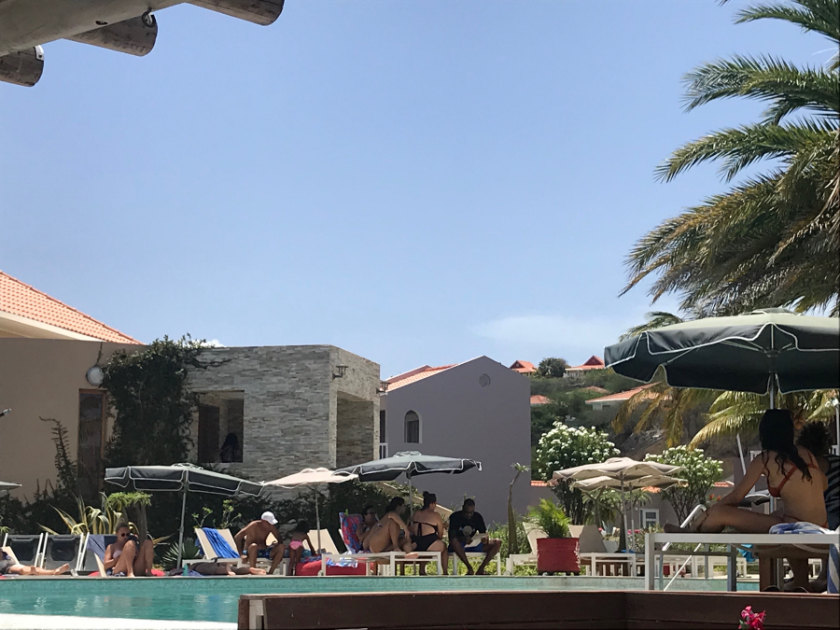
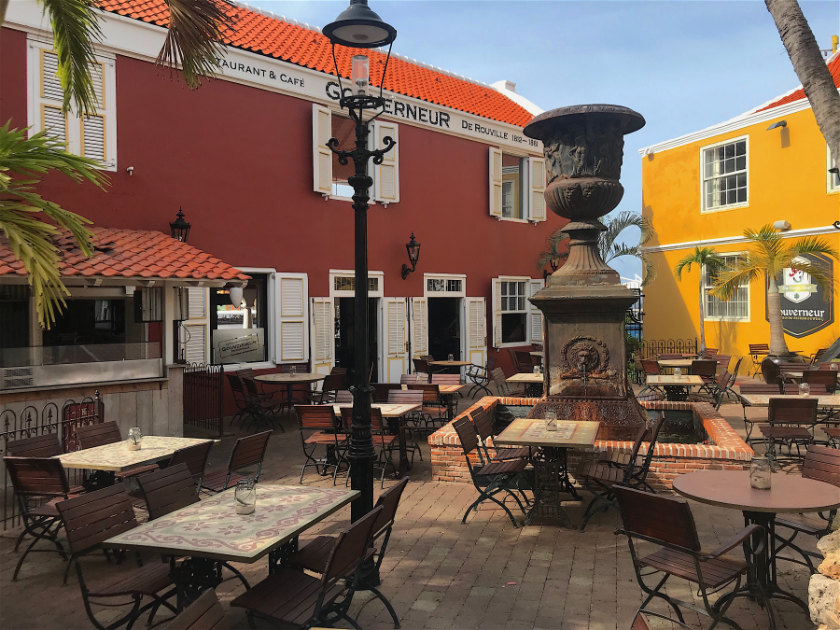
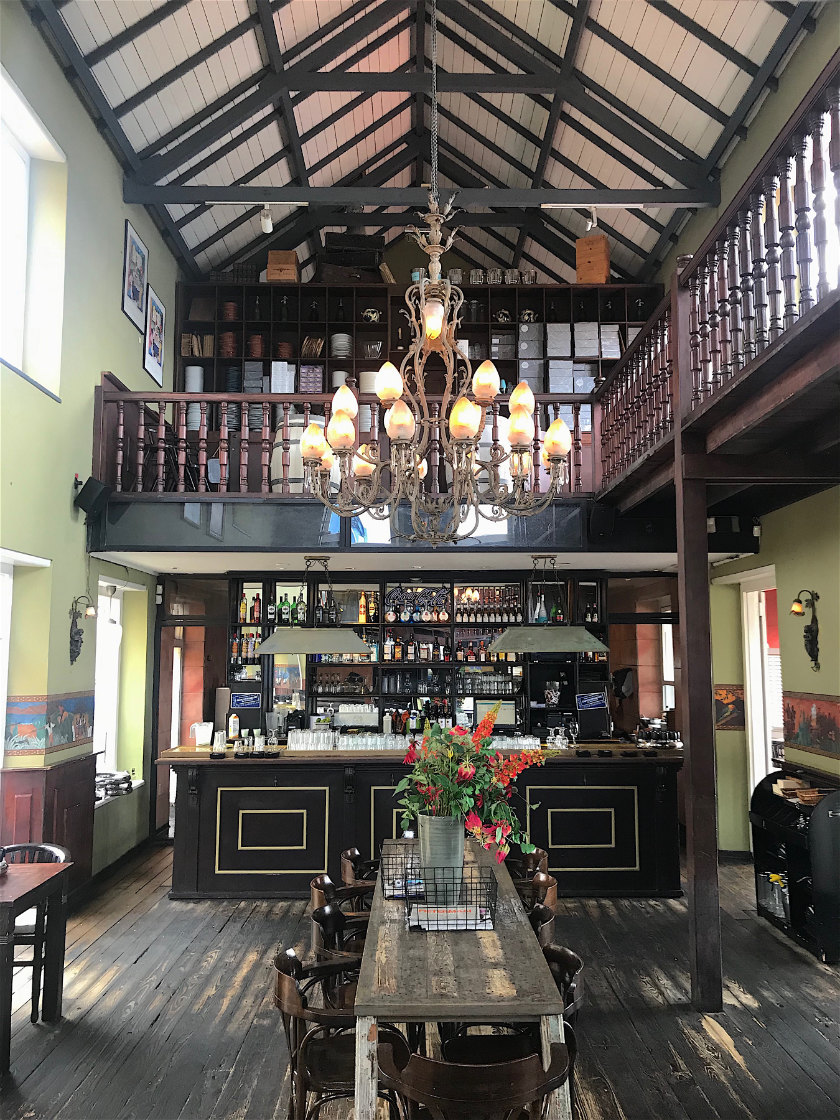 Above, from top: Poolside at Coral Estates. The Gouverneur restaurant. Inside the Gouverneur.
Above, from top: Poolside at Coral Estates. The Gouverneur restaurant. Inside the Gouverneur.
Related articles hand-picked by our editors
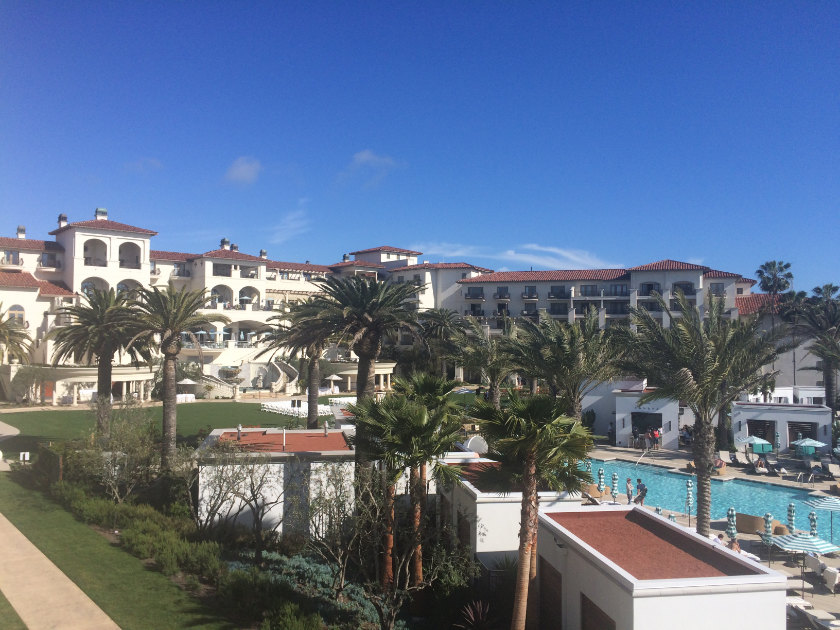
California’s Costa Mesa: the new mecca
Jody Miller heads to Orange County and the city of Costa Mesa, now a true food and shopping escape for Californians
Photographed by Elyse Glickman
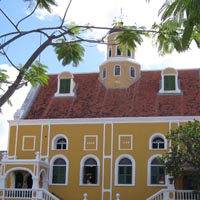 Curaçao: on a higher plane
Curaçao: on a higher plane
All Caribbean islands offer diving, luxury resorts and deeply discounted
diamonds and designer labels. Curaçao’s rich, multicultural
history, meanwhile, carries the tropical retreat experience to a higher
plane, writes Elyse Glickman
Photographed by the author
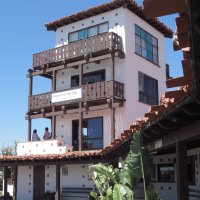 Return to paradise
Return to paradise
Stanley Moss finds a jewel very near Long Beach, California: Catalina Island manages to combine a sense of mystery, art, history and luxury, all with an otherworldly feel
Photographed by the author
Advertisement
Copyright ©1997–2022 by JY&A Media, part of Jack Yan & Associates. All rights reserved. JY&A terms and conditions and privacy policy apply to viewing this site. All prices in US dollars except where indicated. Contact us here.